Discover 50 hidden attractions, cool sights, and unusual things to do in Italy. Don't miss out on these must-see attractions: Colosseum (Rome), St. Peter's Basilica (Rome) or Archbasilica of Saint John Lateran (Rome).
Below, you can find the list of the most amazing places you should visit in Italy.
Table of Contents
Colosseum, Rome
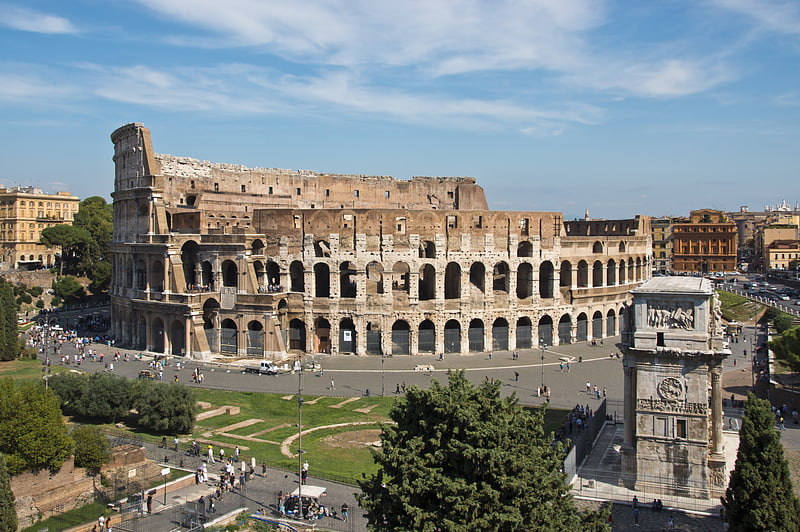
Also known as: Colosseo
Iconic ancient Roman gladiatorial arena. The Colosseum is an oval amphitheatre in the centre of the city of Rome, Italy, just east of the Roman Forum. It is the largest ancient amphitheatre ever built, and is still the largest standing amphitheatre in the world today, despite its age. Construction began under the emperor Vespasian in 72 and was completed in 80 AD under his successor and heir, Titus. Further modifications were made during the reign of Domitian. The three emperors that were patrons of the work are known as the Flavian dynasty, and the amphitheatre was named the Flavian Amphitheatre by later classicists and archaeologists for its association with their family name.
The Colosseum is built of travertine limestone, tuff (volcanic rock), and brick-faced concrete. It could hold an estimated 50,000 to 80,000 spectators at various points in its history, having an average audience of some 65,000; it was used for gladiatorial contests and public spectacles including animal hunts, executions, re-enactments of famous battles, and dramas based on Roman mythology, and briefly mock sea battles. The building ceased to be used for entertainment in the early medieval era. It was later reused for such purposes as housing, workshops, quarters for a religious order, a fortress, a quarry, and a Christian shrine.
Although substantially ruined because of earthquakes and stone-robbers (for spolia), the Colosseum is still an iconic symbol of Imperial Rome and was listed as one of the New7Wonders of the World. It is one of Rome's most popular tourist attractions and also has links to the Roman Catholic Church, as each Good Friday the Pope leads a torchlit "Way of the Cross" procession that starts in the area around the Colosseum. The Colosseum is depicted on the Italian version of the five-cent euro coin.[1]
Address: Piazza del Colosseo, 00184 Rome
St. Peter's Basilica, Rome
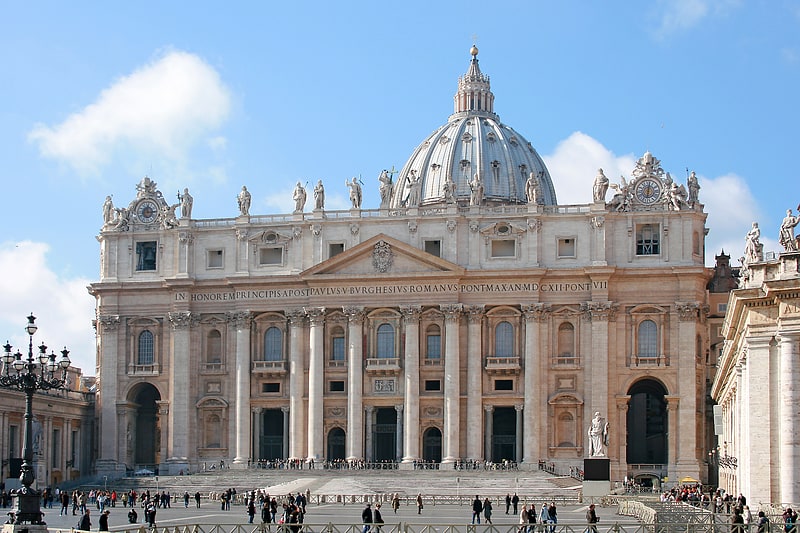
Also known as: Basilica di San Pietro in Vaticano
World’s largest basilica of Christianity. The Papal Basilica of Saint Peter in the Vatican, or simply Saint Peter's Basilica, is a church built in the Renaissance style located in Vatican City, the papal enclave that is within the city of Rome, Italy. It was initially planned by Pope Nicholas V and then Pope Julius II to replace the aging Old St. Peter's Basilica, which was built in the fourth century by Roman emperor Constantine the Great. Construction of the present basilica began on 18 April 1506 and was completed on 18 November 1626.
Designed principally by Donato Bramante, Michelangelo, Carlo Maderno and Gian Lorenzo Bernini, St. Peter's is the most renowned work of Renaissance architecture and the largest church in the world by interior measure. While it is neither the mother church of the Catholic Church nor the cathedral of the Diocese of Rome (these equivalent titles being held by the Archbasilica of Saint John Lateran in Rome), St. Peter's is regarded as one of the holiest Catholic shrines. It has been described as "holding a unique position in the Christian world" and as "the greatest of all churches of Christendom."
Catholic tradition holds that the basilica is the burial site of Saint Peter, chief among Jesus's apostles and also the first Bishop of Rome (Pope). Saint Peter's tomb is supposedly directly below the high altar of the basilica, also known as the Altar of the Confession. For this reason, many popes have been interred at St. Peter's since the Early Christian period.
St. Peter's is famous as a place of pilgrimage and for its liturgical functions. The pope presides at a number of liturgies throughout the year both within the basilica or the adjoining St. Peter's Square; these liturgies draw audiences numbering from 15,000 to over 80,000 people. St. Peter's has many historical associations, with the Early Christian Church, the Papacy, the Protestant Reformation and Catholic Counter-reformation and numerous artists, especially Michelangelo. As a work of architecture, it is regarded as the greatest building of its age. St. Peter's is one of the four churches in the world that hold the rank of Major papal basilica, all four of which are in Rome, and is also one of the Seven Pilgrim Churches of Rome. Contrary to popular misconception, it is not a cathedral because it is not the seat of a bishop; the cathedra of the pope as Bishop of Rome is at Saint John Lateran.[2]
Address: Piazza San Pietro, 00120 Città del Vaticano
Archbasilica of Saint John Lateran, Rome
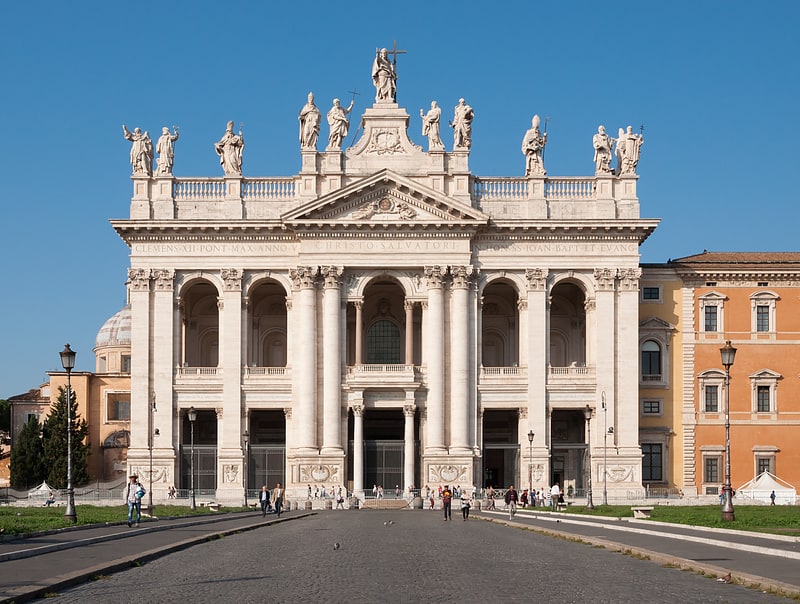
Also known as: Basilica di San Giovanni in Laterano
Cathedral in Rome, Italy. The Cathedral of the Most Holy Savior and of Saints John the Baptist and John the Evangelist in the Lateran, also known as the Papal Archbasilica of Saint John Lateran, Saint John Lateran, or the Lateran Basilica, is the cathedral church of the Diocese of Rome in the city of Rome, and serves as the seat of the bishop of Rome, the pope. The archbasilica lies outside of Vatican City proper, which is located approximately 4 kilometres to the northwest. Nevertheless, as properties of the Holy See, the archbasilica and its adjoining edifices enjoy an extraterritorial status from Italy, pursuant to the terms of the Lateran Treaty of 1929.
The church is the oldest and highest ranking of the four major papal basilicas as well as one of the Seven Pilgrim Churches of Rome, holding the unique title of "archbasilica". Originally founded in 324, it is the oldest public church in the city of Rome, and the oldest basilica of the Western world. It houses the cathedra of the Roman bishop, and has the title of ecumenical mother church of the Roman Catholic faithful. The building deteriorated during the Middle Ages and was badly damaged by two fires in the 14th century. It was rebuilt in the late 16th century during the reign of Pope Sixtus V. The new structure's interior was renovated in the late 17th century, and its façade was completed in 1735 under Pope Clement XII.
The current rector is Cardinal Archpriest Angelo De Donatis, Vicar General for the Diocese of Rome. The President of the French Republic, currently Emmanuel Macron, is ex officio the "First and Only Honorary Canon" of the archbasilica, a title that the heads of state of France have possessed since King Henry IV.
The large Latin inscription on the façade reads: Clemens XII Pont Max Anno V Christo Salvatori In Hon SS Ioan Bapt et Evang. This abbreviated inscription translates as: "Pope Clement XII, in the fifth year to Christ the Savior, in honor of Saints John the Baptist and the Evangelist". The inscription indicates, with its full title (see below), that the archbasilica was originally dedicated to Christ the Savior and, centuries later, co-dedicated to Saint John the Baptist and Saint John the Evangelist. Christ the Savior remains its primary dedication, and its titular feast day is 6 August, the Transfiguration of Christ. As the Cathedral of the Pope as Bishop of Rome, it ranks superior to all other churches of the Roman Catholic Church, including Saint Peter's Basilica.[3]
Address: Piazza di S. Giovanni in Laterano, 4, 00184 Roma
Florence Baptistery, Florence
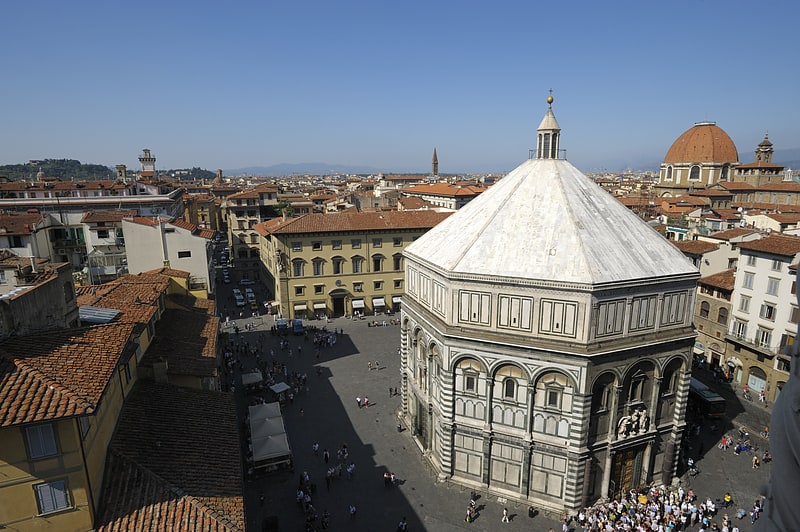
Also known as: Battistero di San Giovanni
Landmark marble-clad religious monument. The Florence Baptistery, also known as the Baptistery of Saint John, is a religious building in Florence, Italy, and has the status of a minor basilica. The octagonal baptistery stands in both the Piazza del Duomo and the Piazza San Giovanni, across from Florence Cathedral and the Campanile di Giotto.
The Baptistery is one of the oldest buildings in the city, constructed between 1059 and 1128 in the Florentine Romanesque style. Although the Florentine style did not spread across Italy as widely as the Pisan Romanesque or Lombard styles, its influence was decisive for the subsequent development of architecture, as it formed the basis from which Francesco Talenti, Leon Battista Alberti, Filippo Brunelleschi, and other master architects of their time created Renaissance architecture. In the case of the Florentine Romanesque, one can speak of "proto-renaissance", but at the same time an extreme survival of the late antique architectural tradition in Italy, as in the cases of the Basilica of San Salvatore, Spoleto, the Temple of Clitumnus, and the church of Sant'Alessandro in Lucca.
The Baptistery is renowned for its three sets of artistically important bronze doors with relief sculptures. The south doors were created by Andrea Pisano and the north and east doors by Lorenzo Ghiberti. Michelangelo dubbed the east doors the Gates of Paradise.
The Italian poet Dante Alighieri and many other notable Renaissance figures, including members of the Medici family, were baptized in this baptistery.
The building contains the monumental tomb of Antipope John XXIII, by Donatello.[4]
Address: Piazza San Giovanni, 50122 Firenze (Centro Storico)
Uffizi, Florence
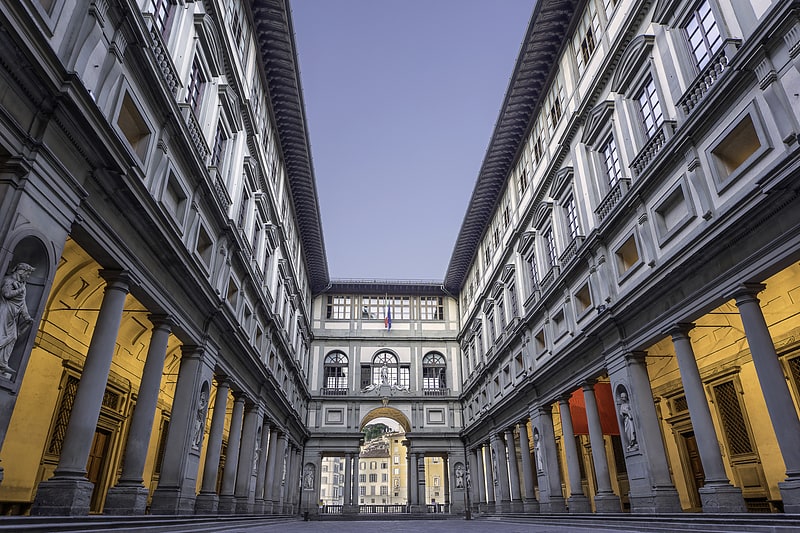
Art museum with Renaissance masterpieces. The Uffizi Gallery is a prominent art museum located adjacent to the Piazza della Signoria in the Historic Centre of Florence in the region of Tuscany, Italy. One of the most important Italian museums and the most visited, it is also one of the largest and best known in the world and holds a collection of priceless works, particularly from the period of the Italian Renaissance.
After the ruling House of Medici died out, their art collections were given to the city of Florence under the famous Patto di famiglia negotiated by Anna Maria Luisa, the last Medici heiress. The Uffizi is one of the first modern museums. The gallery had been open to visitors by request since the sixteenth century, and in 1765 it was officially opened to the public, formally becoming a museum in 1865.[5]
Address: Piazzale degli Uffizi, 6, 50122 Firenze (Centro Storico)
Piazza San Marco, Venice
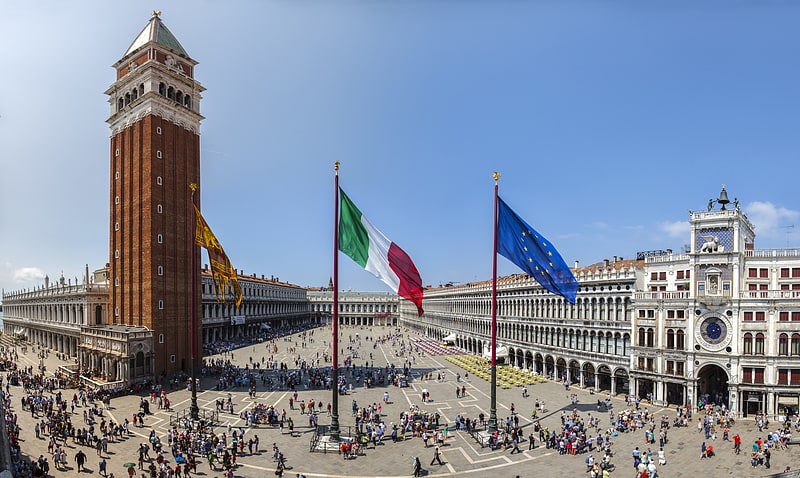
Plaza in Venice, Italy. Piazza San Marco, often known in English as St Mark's Square, is the principal public square of Venice, Italy, where it is generally known just as la Piazza. All other urban spaces in the city are called campi. The Piazzetta is an extension of the Piazza towards San Marco basin in its south east corner. The two spaces together form the social, religious and political centre of Venice and are commonly considered together. This article relates to both of them.
A remark usually attributed (though without proof) to Napoleon calls the Piazza San Marco "the drawing room of Europe".[6]
Address: Piazza San Marco, 30124 Venezia
Doge's Palace, Venice
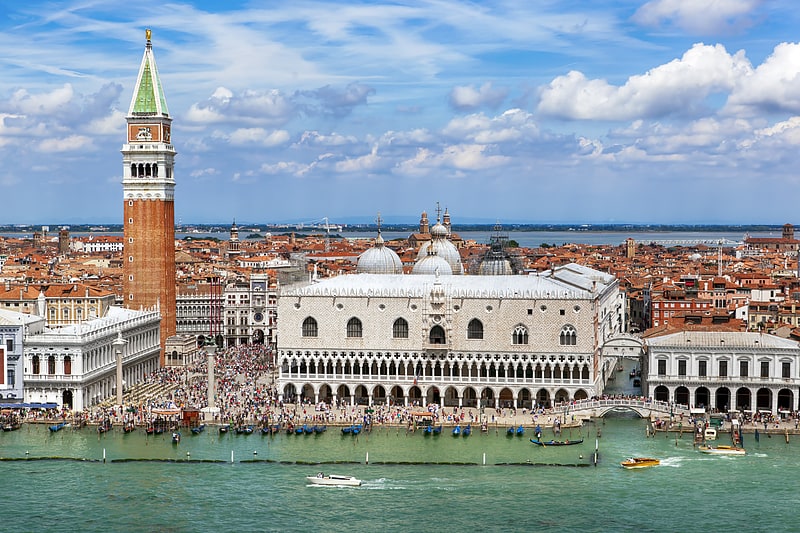
Also known as: Palazzo Ducale
Gothic-style palace and museum. The Doge's Palace is a palace built in Venetian Gothic style, and one of the main landmarks of the city of Venice in northern Italy. The palace was the residence of the Doge of Venice, the supreme authority of the former Republic. It was built in 1340 and extended and modified in the following centuries. It became a museum in 1923 and is one of the 11 museums run by the Fondazione Musei Civici di Venezia.[7]
Address: Piazza San Marco, 1, 30124 Venezia
Santa Maria della Salute, Venice
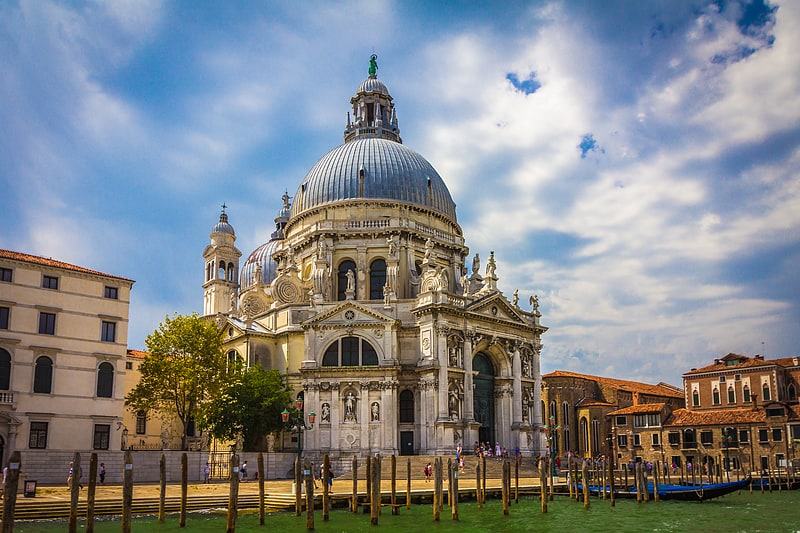
Iconic 1600s church with a vast cupola. Santa Maria della Salute, commonly known simply as the Salute, is a Roman Catholic church and minor basilica located at Punta della Dogana in the Dorsoduro sestiere of the city of Venice, Italy.
It stands on the narrow finger of Punta della Dogana, between the Grand Canal and the Giudecca Canal, at the Bacino di San Marco, making the church visible when entering the Piazza San Marco from the water. The Salute is part of the parish of the Gesuati and is the most recent of the so-called plague churches.
In 1630, Venice experienced an unusually devastating outbreak of the plague. As a votive offering for the city's deliverance from the pestilence, the Republic of Venice vowed to build and dedicate a church to Our Lady of Health. The church was designed in the then fashionable Baroque style by Baldassare Longhena, who studied under the architect Vincenzo Scamozzi. Construction began in 1631. Most of the objects of art housed in the church bear references to the Black Death.
The dome of the Salute was an important addition to the Venice skyline and soon became emblematic of the city, inspiring artists such as Canaletto, J. M. W. Turner, John Singer Sargent, and the Venetian artist Francesco Guardi.[8]
Address: Campo de la Salute Dorsoduro 1, 30123 Venice
Ponte Vecchio, Florence
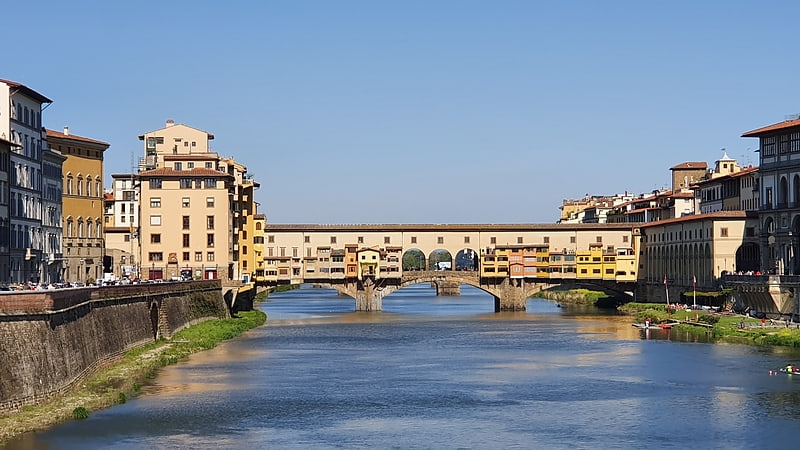
Medieval stone bridge with jewelry shops. The Ponte Vecchio is a medieval stone closed-spandrel segmental arch bridge over the Arno River, in Florence, Italy. It is noted for the shops built along it; building shops on such bridges was once a common practice. Butchers, tanners, and farmers initially occupied the shops; the present tenants are jewelers, art dealers, and souvenir sellers. The Ponte Vecchio's two neighboring bridges are the Ponte Santa Trinita and the Ponte alle Grazie.
The bridge connects via Por Santa Maria (Lungarno degli Acciaiuoli and Lungarno degli Archibusieri) to via de 'Guicciardini (Borgo San Jacopo and via de' Bardi).
The name was given to what was the oldest Florentine bridge when the bridge to the Carraia was built, then called "Ponte Nuovo" in contrast to the pons Vetus. Beyond the historical value, the bridge over time has played a central role in the city road system, starting from when it connected the Roman Florentia with the Via Cassia Nuova commissioned by the emperor Hadrian in 123 AD.
In contemporary times, despite being closed to vehicular traffic, the bridge is crossed by a considerable pedestrian flow generated both by the notoriety of the place itself and by the fact that it connects places of high tourist interest on the two banks of the river: piazza del Duomo, piazza della Signoria on one side with the area of Palazzo Pitti and Santo Spirito in the Oltrarno.
The bridge appears in the list drawn up in 1901 by the General Directorate of Antiquities and Fine Arts, as a monumental building to be considered national artistic heritage.[9]
Address: Borgo S. Jacopo, 16, 50125 Firenze (Centro Storico)
Leaning Tower of Pisa, Pisa
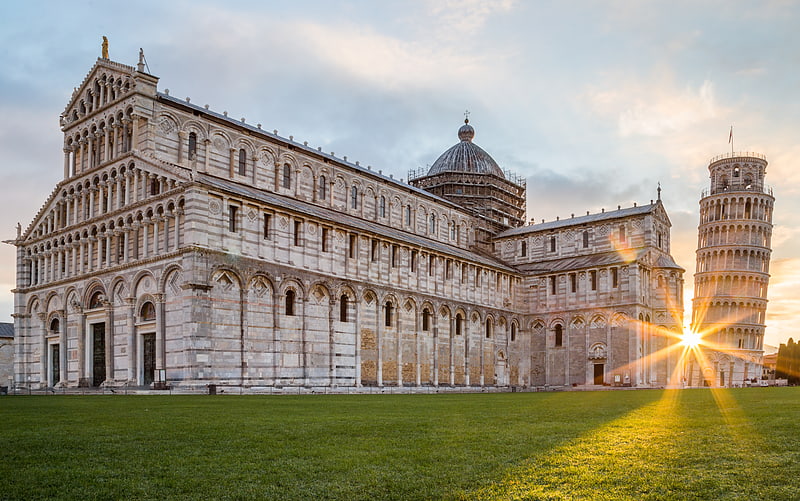
Also known as: Torre di Pisa
Ornate 14th-century tower with a tilt. The Leaning Tower of Pisa, or simply, the Tower of Pisa, is the campanile, or freestanding bell tower, of Pisa Cathedral. It is known for its nearly four-degree lean, the result of an unstable foundation. The tower is one of three structures in the Pisa's Cathedral Square, which includes the cathedral and Pisa Baptistry.
The height of the tower is 55.86 metres (183 feet 3 inches) from the ground on the low side and 56.67 m (185 ft 11 in) on the high side. The width of the walls at the base is 2.44 m (8 ft 0 in). Its weight is estimated at 14,500 tonnes (16,000 short tons). The tower has 296 or 294 steps; the seventh floor has two fewer steps on the north-facing staircase.
The tower began to lean during construction in the 12th century, due to soft ground which could not properly support the structure's weight. It worsened through the completion of construction in the 14th century. By 1990, the tilt had reached 5.5 degrees. The structure was stabilized by remedial work between 1993 and 2001, which reduced the tilt to 3.97 degrees.[10]
Address: Piazza del Duomo, 56126 Pisa
Royal Palace of Turin, Turin
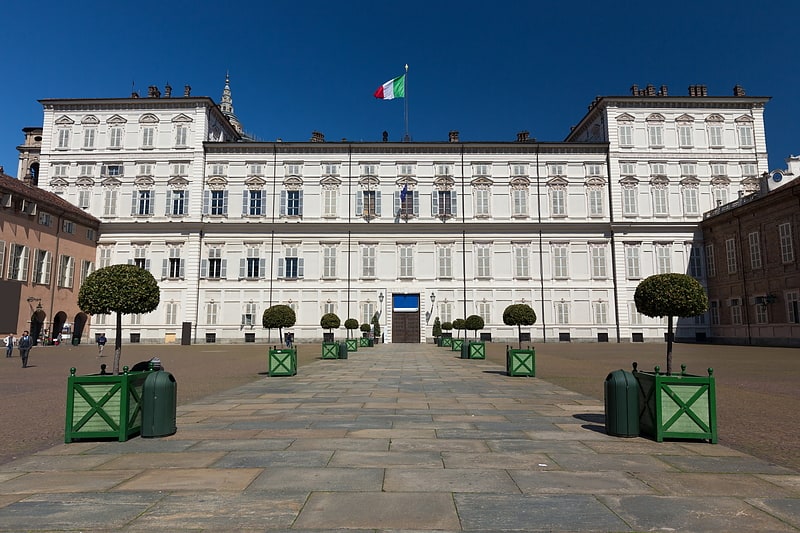
Also known as: Palazzo Reale
Royal residence with armory and museum. The Royal Palace of Turin is a historic palace of the House of Savoy in the city of Turin in Northern Italy. It was originally built in the 16th century and was later modernized by Christine Marie of France in the 17th century, with designs by the Baroque architect Filippo Juvarra. The palace also includes the Palazzo Chiablese and the Chapel of the Holy Shroud, the latter of which was built to house the famous Shroud of Turin. In 1946, the building became the property of the state and was turned into a museum. In 1997, it was placed on the UNESCO World Heritage Site list along with 13 other residences of the House of Savoy.[11]
Address: Turin, Piazzetta Reale 1
Milan Cathedral, Milan

Also known as: Duomo di Milano
Massive Gothic cathedral with artworks. The Milan Cathedral, or Metropolitan Cathedral-Basilica of the Nativity of Saint Mary, is the cathedral church of Milan, Lombardy, Italy. Dedicated to the Nativity of St Mary, it is the seat of the Archbishop of Milan, currently Archbishop Mario Delpini.
The cathedral took nearly six centuries to complete: construction began in 1386, and the final details were completed in 1965. It is the largest church in the Italian Republic—the larger St. Peter's Basilica is in the State of Vatican City, a sovereign state—and possibly the second largest in Europe and the third largest in the world (its size and position remains a matter of debate).[12]
Address: Piazza del Duomo, 20121 Milan (Centro Storico)
Pisa Cathedral, Pisa

Also known as: Duomo di Pisa
Cathedral in Pisa, Italy. Pisa Cathedral is a medieval Roman Catholic cathedral dedicated to the Assumption of the Virgin Mary, in the Piazza dei Miracoli in Pisa, Italy, the oldest of the three structures in the plaza followed by the Pisa Baptistry and the Campanile known as the Leaning Tower of Pisa. The cathedral is a notable example of Romanesque architecture, in particular the style known as Pisan Romanesque. Consecrated in 1118, it is the seat of the Archbishop of Pisa. Construction began in 1063 and was completed in 1092. Additional enlargements and a new facade were built in the 12th century and the roof was replaced after damage from a fire in 1595.[13]
Address: Piazza del Duomo, 56126 Pisa
Acquario di Genova, Genoa
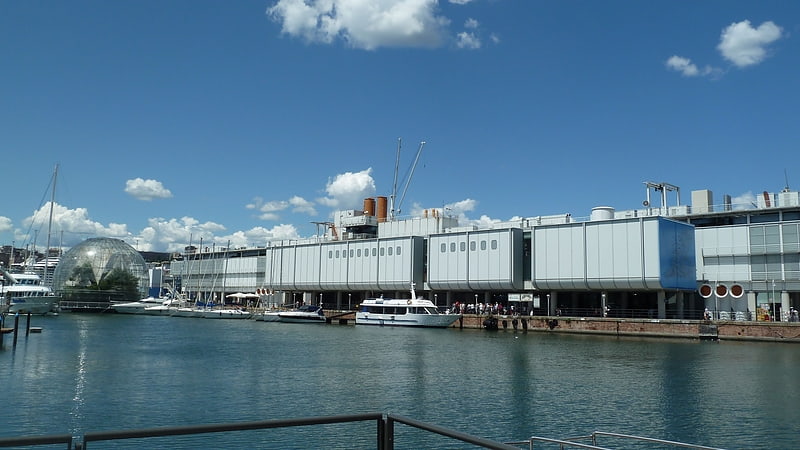
Vast aquarium in ship-like building. The Aquarium of Genoa is the largest aquarium in Italy. Located in the old harbour area of Genoa, Italy, the 33,000-square-foot aquarium is a member organization of the European Association of Zoos and Aquaria, and welcomes more than 1.2 million visitors each year.[14]
Address: Ponte Spinola, 16128 Genova
Piazza del Campo, Siena
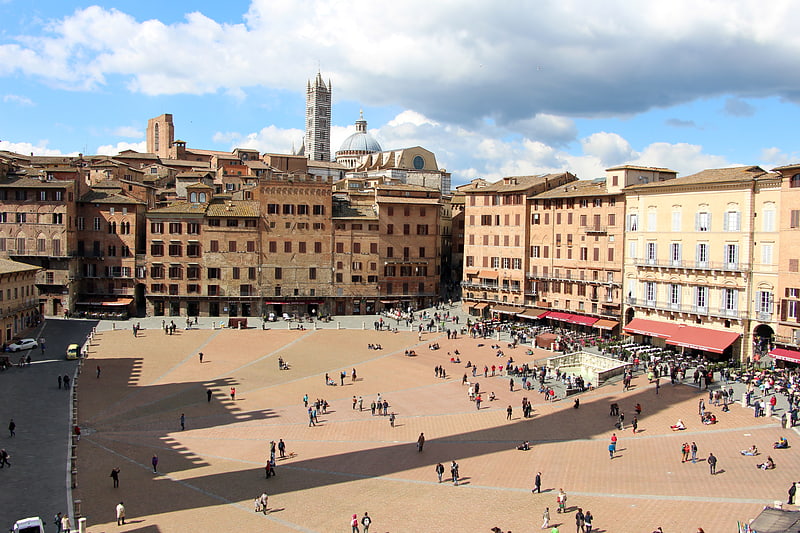
Square popular for public celebrations. Piazza del Campo is the main public space of the historic center of Siena, Tuscany, Italy and is regarded as one of Europe's greatest medieval squares. It is renowned worldwide for its beauty and architectural integrity. The Palazzo Pubblico and its Torre del Mangia, as well as various palazzi signorili surround the shell-shaped piazza. At the northwest edge is the Fonte Gaia.
The twice-a-year horse-race, Palio di Siena, is held around the edges of the piazza. The piazza is also the finish of the annual road cycling race Strade Bianche.[15]
Address: Il Campo, 53100 Siena
Siena Cathedral, Siena
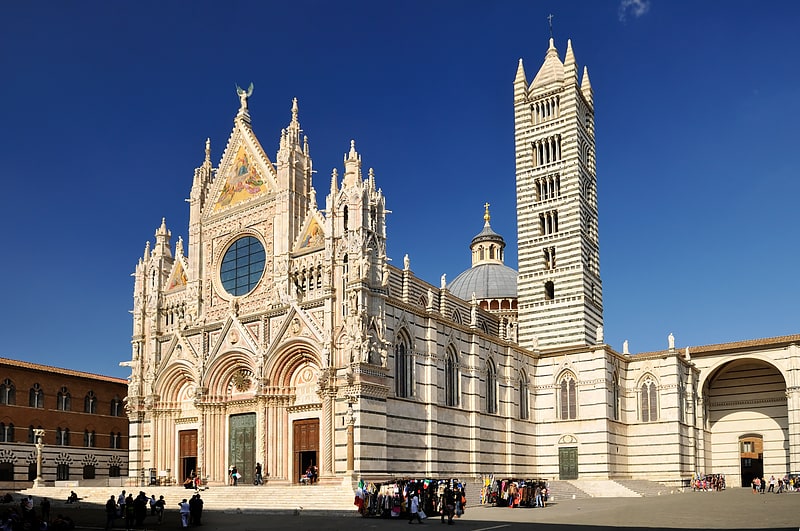
Also known as: Duomo di Siena
Romanesque-Gothic cathedral with mosaics. Siena Cathedral is a medieval church in Siena, Italy, dedicated from its earliest days as a Roman Catholic Marian church, and now dedicated to the Assumption of Mary.
It was the episcopal seat of the Diocese of Siena, and from the 15th century that of the Archdiocese of Siena. It is now the seat of the Archdiocese of Siena-Colle di Val d'Elsa-Montalcino.
The cathedral was designed and completed between 1215 and 1263 on the site of an earlier structure. It has the form of a Latin cross with a slightly projecting transept, a dome and a bell tower. The dome rises from a hexagonal base with supporting columns. The dome was completed in 1264. The lantern atop the dome was added by Gian Lorenzo Bernini. The bell tower has six bells, where the oldest one was cast in 1149. The nave is separated from the two aisles by semicircular arches. The exterior and interior are constructed of white and greenish-black marble in alternating stripes, with the addition of red marble on the façade. Black and white are the symbolic colors of Siena, etiologically linked to black and white horses of the legendary city's founders, Senius and Aschius. There are thirty-five statues of prophets and patriarchs grouped around the virgin. The finest Italian artists of that era completed works in the cathedral. These artists were Nicola and Giovanni Pisano, Donatello, Pinturicchio, Lorenzo Ghiberti, and Bernini.[16]
Address: Piazza del Duomo, 8, 53100 Siena
National Museum of Cinema, Turin
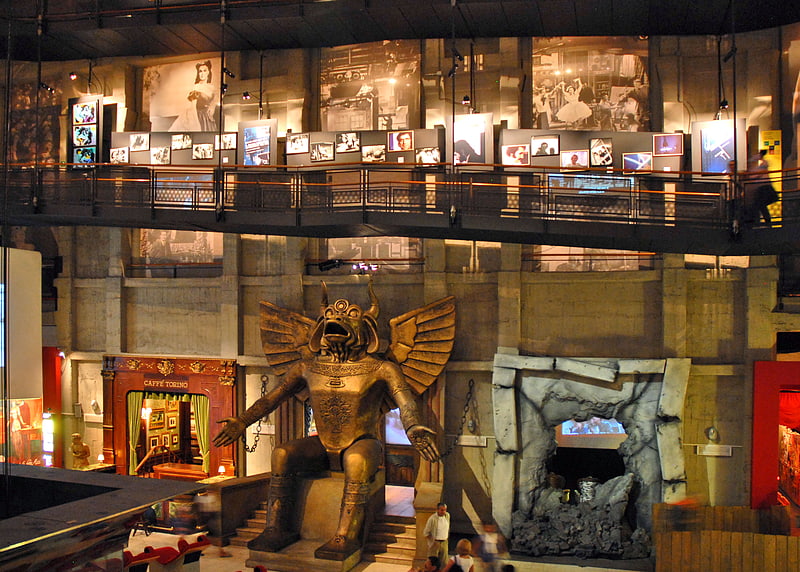
Also known as: Museo nazionale del cinema
Cinema museum in a landmark tower. The National Museum of Cinema located in Turin, Italy, is a motion picture museum fitted out inside the Mole Antonelliana tower. It is operated by the Maria Adriana Prolo Foundation, and the core of its collection is the result of the work of the historian and collector Maria Adriana Prolo. It was housed in the Palazzo Chiablese.
In 2008, with 532,196 visitors, it reached the thirteenth place among the most visited Italian museums.[17]
Address: Via Montebello, 20/A, 10124 Torino (Circoscrizione 1)
Church of Holy Mary of Grace, Milan
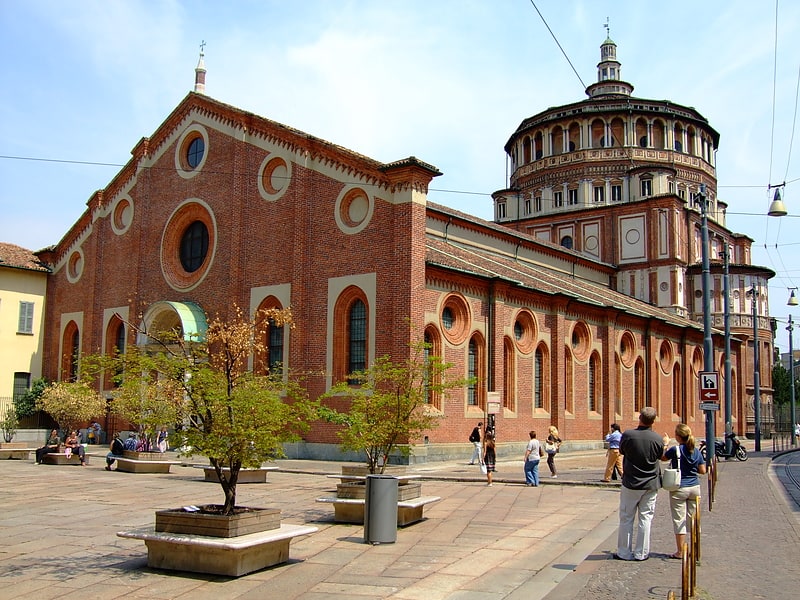
Also known as: Chiesa di Santa Maria delle Grazie
Church with Da Vinci's The Last Supper. Santa Maria delle Grazie is a church and Dominican convent in Milan, northern Italy, and a UNESCO World Heritage Site. The church contains the mural of The Last Supper by Leonardo da Vinci, which is in the refectory of the convent.[18]
Address: Piazza di Santa Maria delle Grazie, 20123 Milano (Centro Storico)
Gallerie d'Italia, Milan
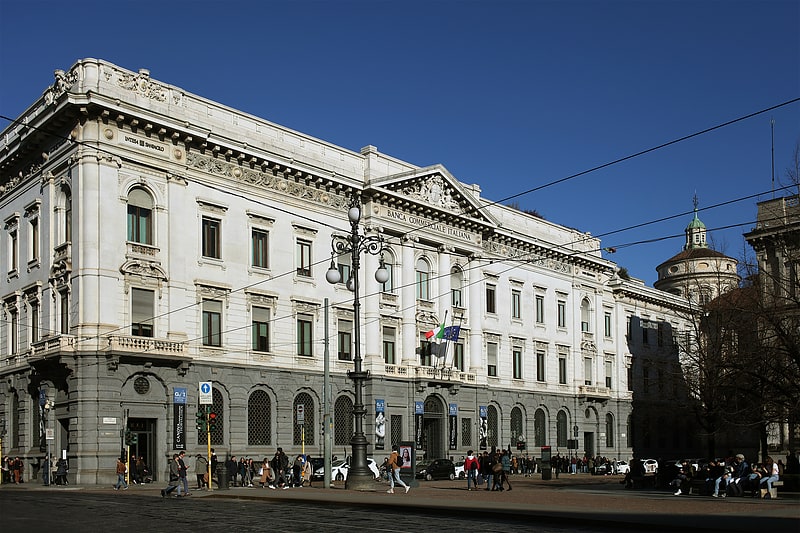
Also known as: Gallerie di piazza Scala
Museum. The Gallerie di Piazza Scala is a modern and contemporary museum in Milan, Italy. Located in Piazza della Scala in the Palazzo Brentani and the Palazzo Anguissola, it hosts 195 artworks from the collections of Fondazione Cariplo with a strong representation of nineteenth century Lombard painters and sculptors, including Antonio Canova and Umberto Boccioni. A new section was opened in the Palazzo della Banca Commerciale Italiana on October 25, 2012 with 189 art works from the twentieth century.
During the 2017 Corporate Art Awards Ceremony hosted by the President of the Italian Republic Sergio Mattarella at the Quirinal Palace, Gallerie di Piazza Scala received a special award as “Patron of the XXI century”.[19]
Address: Piazza della Scala, 6, 20121 Milano (Centro Storico)
Palazzi dei Rolli, Genoa
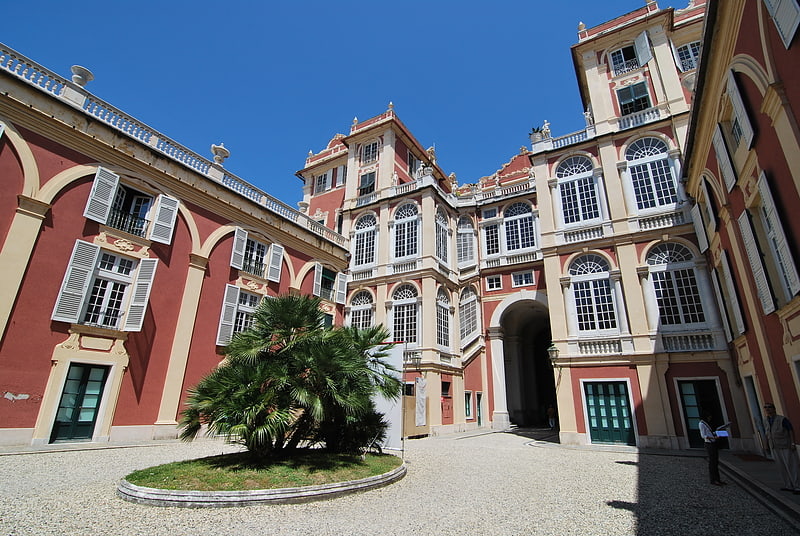
Historical place in Genoa, Italy. Genoa: Le Strade Nuove and the system of the Palazzi dei Rolli is a UNESCO World Heritage Site which includes a number of streets and palaces in the center of Genoa, in Northwestern Italy.
- The Strade Nuove are a group of streets built by the Genoese aristocracy during the expansion of the city at a time when the Republic of Genoa was at the height of its financial and seafaring power. These are Via Giuseppe Garibaldi and Via Balbi, later followed by Via Cairoli.
- The Palazzi dei Rolli are a group of palaces - most of which also date from the late 16th and early 17th centuries - which were associated to a particular system of ‘public lodging’ in private residences, whereby notable guests on State visit to the Republic were hosted in one of these palaces on behalf of the State.
On 13 July 13, 2006, forty-two of the 163 palaces originally included in one the five public list called "Rolli" were selected as a World Heritage Site by the UNESCO special committee meeting in Vilnius. The site includes an ensemble of Renaissance and Baroque palaces along the so-called ‘new streets’, which offer an extraordinary variety of different solutions, achieving universal value in adapting to the particular characteristics of the site and to the requirements of a specific social and economic organization. They also offer an original example of a public network of private residences designated to host state visits.
On January 20, 2007, UNESCO unveiled a plaque in via Garibaldi, the former Strada Nuova, explaining the reasons for inclusion of the Strade Nuove and the system of the Palazzi dei Rolli within the World Heritage Sites:
The largest homes, various in shape and distribution, that were chosen at random in the lists to host visits of state. The buildings, often built on sloping land, formed of a stepped atrium - courtyard - staircase - garden and rich interior decorations, express a singular social and economic identity and commencement of modern age urban architecture in Europe.
Some of the Palazzi dei Rolli are used today as public buildings, museums, offices and private residences. Among the palaces open to the public, Palazzo Rosso, Palazzo Bianco and Palazzo Doria Tursi jointly constitute the Strada Nuova Museums located in via Garibaldi.[20]
Address: Via Garibaldi, 16124 Genoa (Centro Est)
Pisa Baptistery, Pisa

Also known as: Battistero di San Giovanni
Celebrated acoustics and Gothic sculptures. The Pisa Baptistery of St. John is a Roman Catholic ecclesiastical building in Pisa, Italy. Construction started in 1152 to replace an older baptistery, and when it was completed in 1363, it became the second building, in chronological order, in the Piazza dei Miracoli, near the Duomo di Pisa and the cathedral's free-standing campanile, the famous Leaning Tower of Pisa. The baptistery was designed by Diotisalvi, whose signature can be read on two pillars inside the building, with the date 1153.[21]
Address: Piazza del Duomo, 23, 56126 Pisa
Mole Antonelliana, Turin
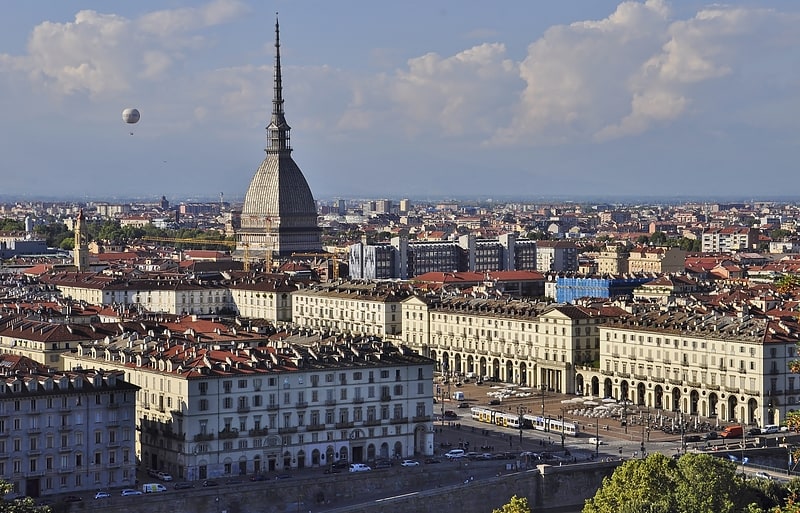
Prominent landmark with cinema museum. The Mole Antonelliana is a major landmark building in Turin, Italy, named after its architect, Alessandro Antonelli. A mole in Italian is a building of monumental proportions.
Construction began in 1863, soon after Italian unification, and was completed in 1889, after the architect's death. Originally conceived of as a synagogue, it now houses the National Museum of Cinema, and is believed to be the tallest museum in the world. A representation of the building is featured on the obverse of the Italian 2 euro cent coin. Catalan vaults are featured in the ceiling of the ground floor under the atrium, which are relatively rare in Italy but popular in Spain, where they originated.[22]
Address: Via Montebello 20, 10124 Turin (Circoscrizione 1)
Amphitheater, Verona
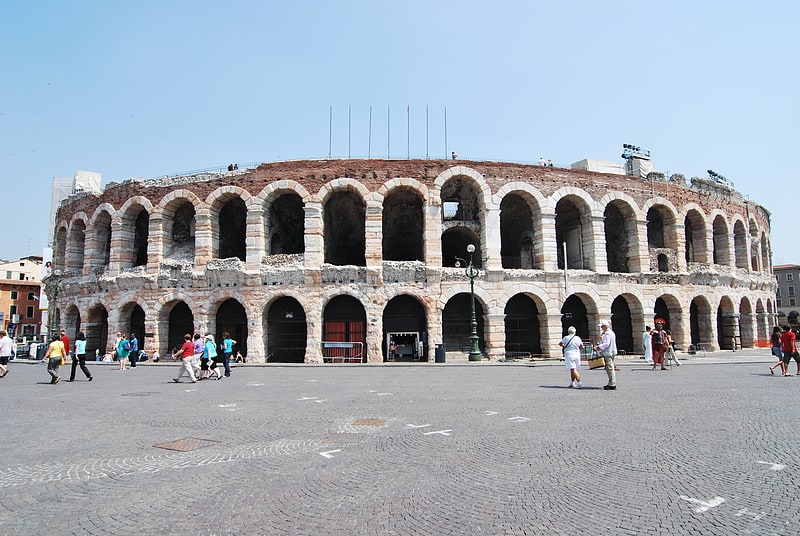
Also known as: Arena di Verona
Roman amphitheater hosting operas. The Verona Arena is a Roman amphitheatre in Piazza Bra in Verona, Italy built in 30 AD. It is still in use today and is internationally famous for the large-scale opera performances given there. It is one of the best preserved ancient structures of its kind. In ancient times, the arena's capacity was nearly 30,000 people. The stage for concerts and opera performances decreases the available places to a maximum of 15,000. It will be used as the Closing ceremony venue for the 2026 Winter Olympics and two weeks later will be used for the Opening Ceremony for the 2026 Winter Paralympics in Milan and Cortina d'Ampezzo.[23]
Address: Piazza Brà, 1, 37121 Verona (Centro Storico)
Villa Capra "La Rotonda", Vicenza
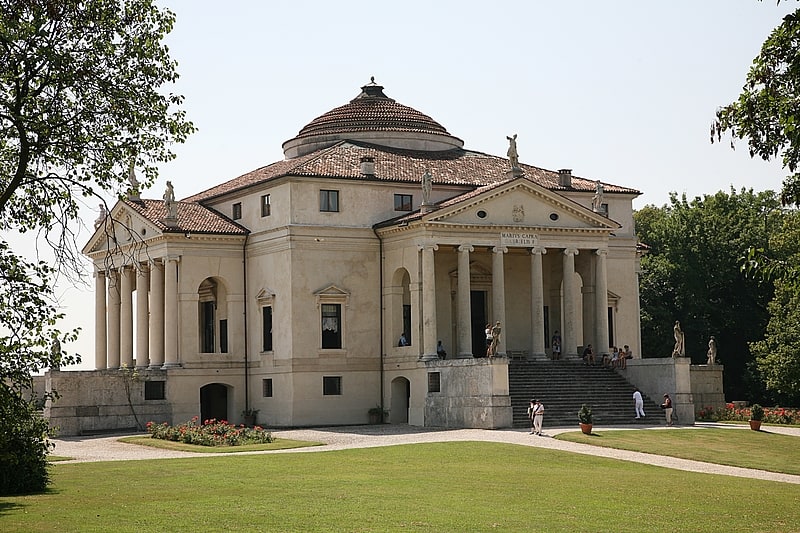
Also known as: Villa Almerico Capra
Renaissance villa hosting private events. Villa La Rotonda is a Renaissance villa just outside Vicenza in northern Italy designed by Italian Renaissance architect Andrea Palladio. The villa’s correct name is Villa Almerico Capra Valmarana, but it is also known as "La Rotonda", "Villa Rotonda", "Villa Capra", and "Villa Almerico Capra". The name Capra derives from the Capra brothers, who completed the building after it was ceded to them in 1592. Along with other works by Palladio, the building is conserved as part of the World Heritage Site "City of Vicenza and the Palladian Villas of the Veneto".[24]
Address: Via della Rotonda, 45, 36100 Vicenza
Museo di Castelvecchio, Verona
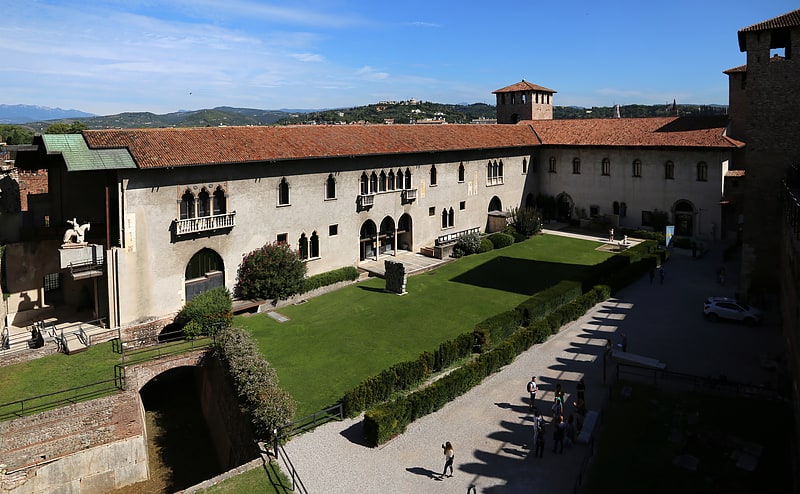
Museum in Verona, Italy. Castelvecchio Museum is a museum in Verona, northern Italy, located in the eponymous medieval castle. Restoration by the architect Carlo Scarpa between 1959 and 1973 has enhanced the appearance of the building and exhibits. Scarpa's architectural style is visible in the details for doorways, staircases, furnishings, and even fixtures designed to hold a specific piece of artwork. The renovation carefully balanced new and old, revealing the history of the original building where appropriate. Unusual at the time, this approach has now become a common approach to renovation.[25]
Address: Corso Castelvecchio, 2, 37121 Verona (Centro Storico)
Museo Archeologico Nazionale, Naples
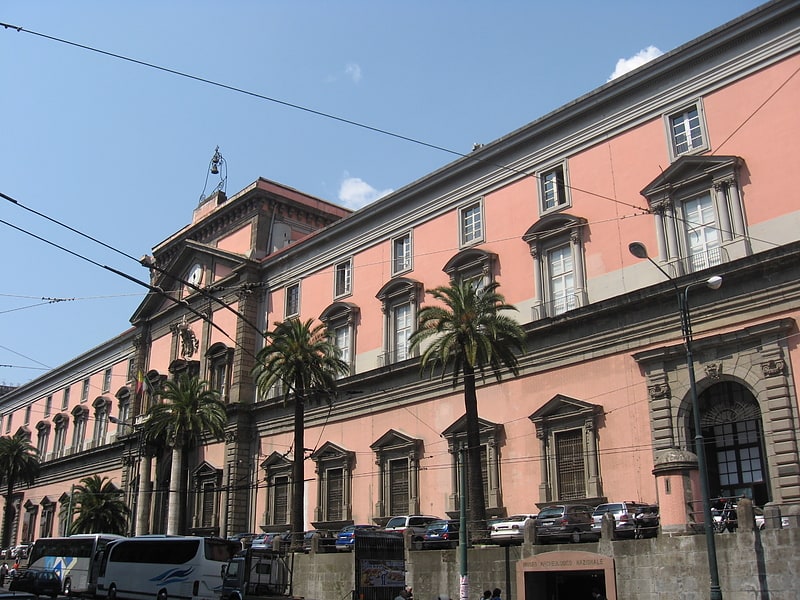
Also known as: Museo archeologico nazionale di Napoli
Museum in Naples, Italy. The National Archaeological Museum of Naples is an important Italian archaeological museum, particularly for ancient Roman remains. Its collection includes works from Greek, Roman and Renaissance times, and especially Roman artifacts from the nearby Pompeii, Stabiae and Herculaneum sites. From 1816 to 1861 it was known as Real Museo Borbonico.[26]
Address: Piazza Museo, 19, 80135 Napoli (Municipalità 4)
Galata Museo del Mare, Genoa
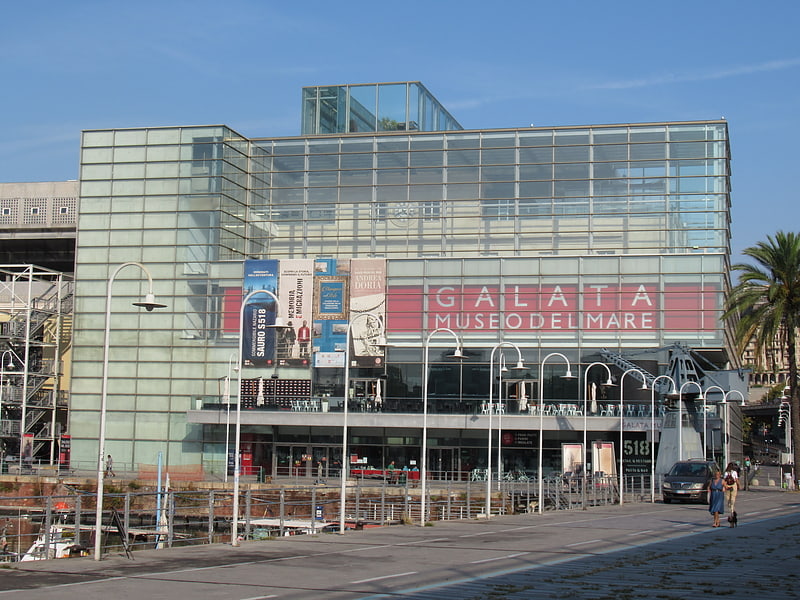
Museum in Genoa, Italy. The Galata - Museo del mare is a maritime museum in the Italian city of Genoa. It is the largest museum of its kind in the Mediterranean area and also one of the most modern in Italy. The museum is located on the grounds of the Porto Antico, in the Palazzo Galata in the Darsena district, where galleys were built in the Republic of Genoa era. It is close to downtown Genoa, the Port of Genoa, and within walking distance of Genova Principe train station and Darsena metro stop. It opened in 2004 as part of Genoa's 2004 European Capital of Culture celebration.[27]
Address: Calata Ansaldo De Mari, 1, 16126 Genova
Miramare Castle, Trieste
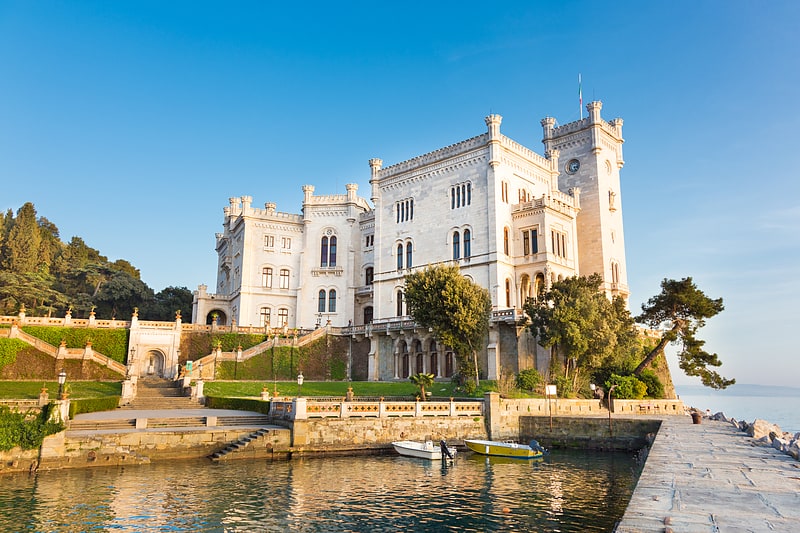
Also known as: Castello di Miramare
Hapsburg residence with period interiors. Miramare Castle is a 19th-century castle direct on the Gulf of Trieste between Barcola and Grignano in Trieste, northeastern Italy. It was built from 1856 to 1860 for Austrian Archduke Ferdinand Maximilian and his wife, Charlotte of Belgium, later Emperor Maximilian I and Empress Carlota of Mexico, based on a design by Carl Junker.
The castle's grounds include an extensive cliff and seashore park of 22 hectares (54 acres) designed by the archduke. The grounds were completely re-landscaped to feature numerous tropical species of trees and plants.[28]
Address: Viale Miramare, 34151 Trieste
Palazzo Reale, Naples

Restored palace and royal apartments. The Royal Palace of Naples is a palace, museum, and historical tourist destination located in central Naples, southern Italy.
It was one of the four residences near Naples used by the House of Bourbon during their rule of the Kingdom of Naples (1735–1816) and later the Kingdom of the Two Sicilies (1816-1861). The others were the palaces of Caserta, Capodimonte overlooking Naples and Portici on the slopes of Vesuvius.[29]
Address: Piazza del Plebiscito, 1, 80132 Napoli (Municipalità 1)
Ear of Dionysius, Syracuse
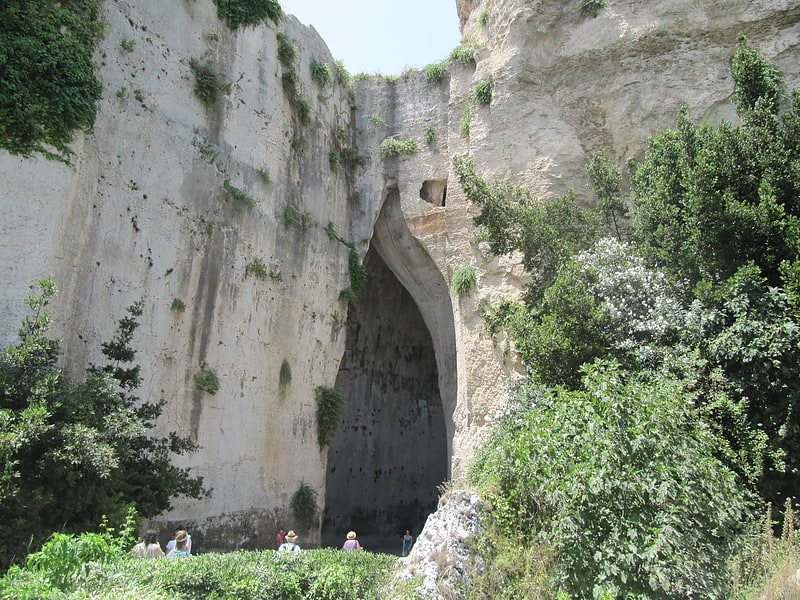
Also known as: Orecchio di Dionisio
Limestone cave known as Ear of Dionysius. The Ear of Dionysius is a limestone cave carved out of the Temenites hill in the city of Syracuse, on the island of Sicily in Italy. Its name, given by the painter Michelangelo da Caravaggio, comes from its similarity in shape to the human ear. The name is also linked to the acoustic effects inside the cave: it is said that people's voices echo up to 16 times.[30]
Address: Via Paradiso, 14, 96100 Siracusa
Palazzo Pubblico, Siena

Gothic style town hall building and tower. The Palazzo Pubblico is a palace in Siena, Tuscany, central Italy. Construction began in 1297 to serve as the seat of the Republic of Siena's government, which consisted of the Podestà and Council of Nine, the elected officials who performed executive functions.[31]
Address: Piazza del Campo, 1, 53100 Siena
Palazzo Chiericati, Vicenza
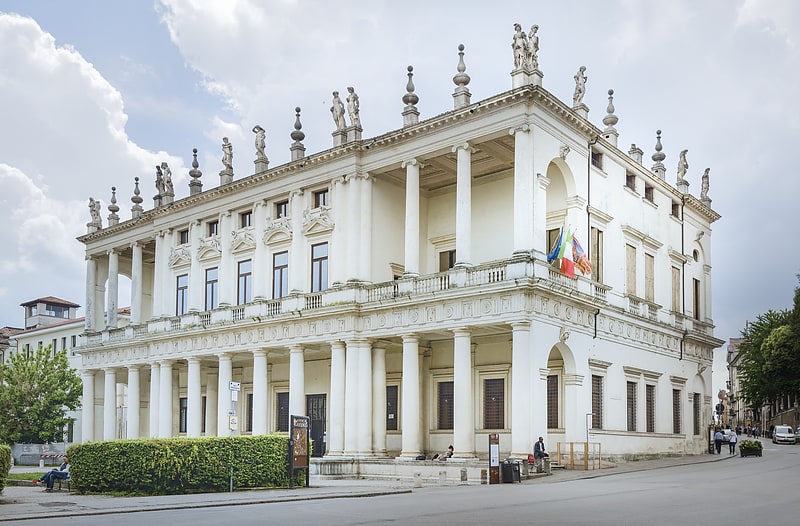
16th-century palace and art museum. The Palazzo Chiericati is a Renaissance palace in Vicenza, designed by Andrea Palladio.[32]
Address: Piazza Giacomo Matteotti, 37/39, 36100 Vicenza
Palermo Cathedral, Palermo
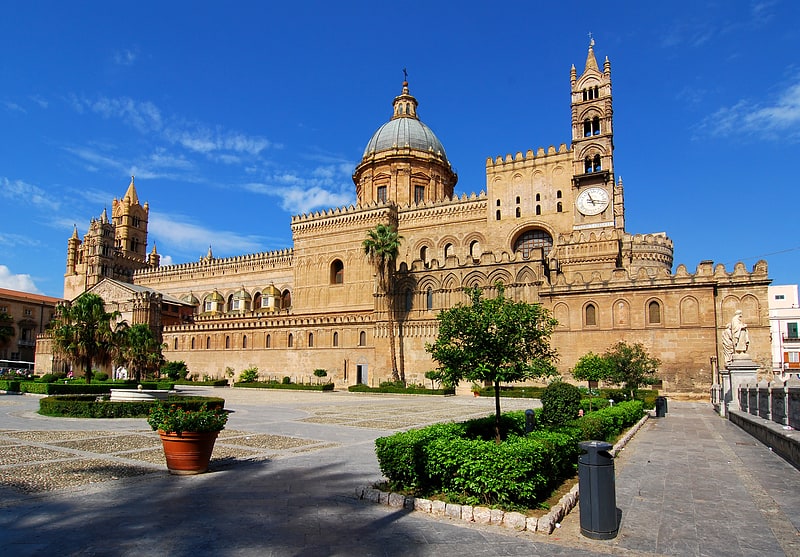
Also known as: Cattedrale di Palermo
12th-century structure with royal tombs. Palermo Cathedral is the cathedral church of the Roman Catholic Archdiocese of Palermo, located in Palermo, Sicily, southern Italy. It is dedicated to the Assumption of the Virgin Mary. As an architectural complex, it is characterized by the presence of different styles, due to a long history of additions, alterations and restorations, the last of which occurred in the 18th century.[33]
Address: Via Vittorio Emanuele, 90040 Palermo (Centro Storico)
Museo nazionale di San Martino, Naples
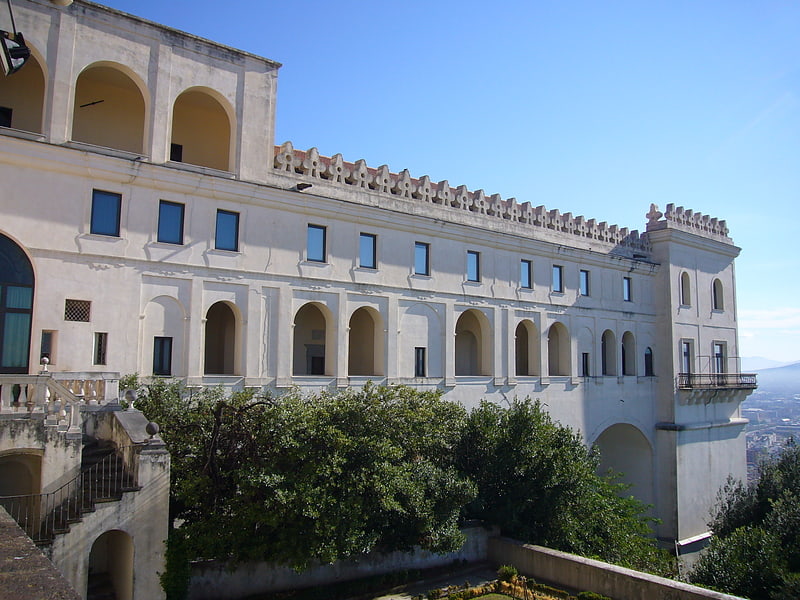
Museum in Italy. The National Museum of San Martino is a museum opened to the public in Naples in 1866, after the unification of Italy, after the Charterhouse included among the suppressed ecclesiastical assets, was declared a national monument.
By the will of the Neapolitan archaeologist Giuseppe Fiorelli, the rooms were intended to collect in a museum evidence of the life of Naples and the southern Kingdoms (Kingdom of Naples and Kingdom of Sicily first and the Kingdom of the Two Sicilies after). The museum, which is spread over two levels, is accessed from the two cloisters of the charterhouse.
Since December 2014, the Ministry of Cultural Heritage and Activities has been managing the museum and charterhouse through the Campania museum complex, which in December 2019 became the Regional Directorate for Museums.[34]
Basilica di San Vitale, Ravenna
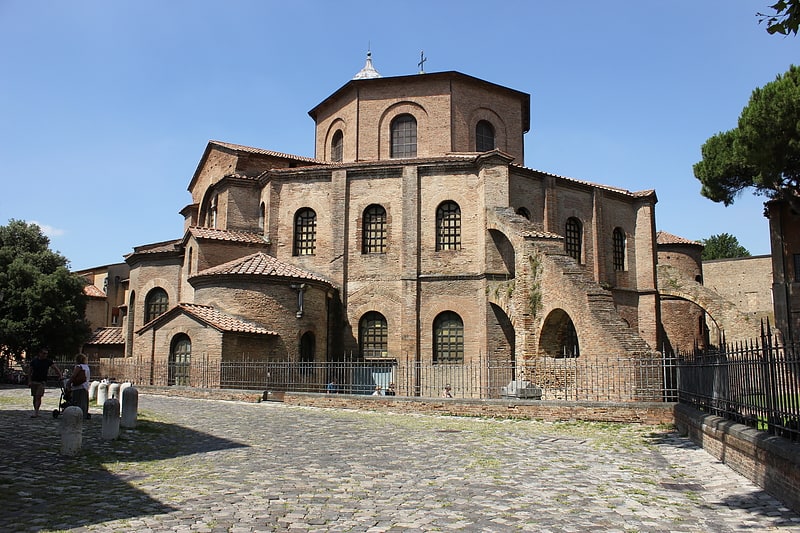
Colorful mosaics in a 6th-century church. The Basilica of San Vitale is a late antique church in Ravenna, Italy. The 6th century church is an important surviving example of early Christian Byzantine art and architecture. It is one of eight structures in Ravenna inscribed on the UNESCO World Heritage List. Its foundational inscription describes the church as a basilica, though its centrally-planned design is not typical of the basilica form. The Roman Catholic Church has designated the building a "basilica", an honorific title bestowed on exceptional church buildings of historic and ecclesial importance.[35]
Address: Via San Vitale, 17, 48121 Ravenna
Catania Cathedral, Catania
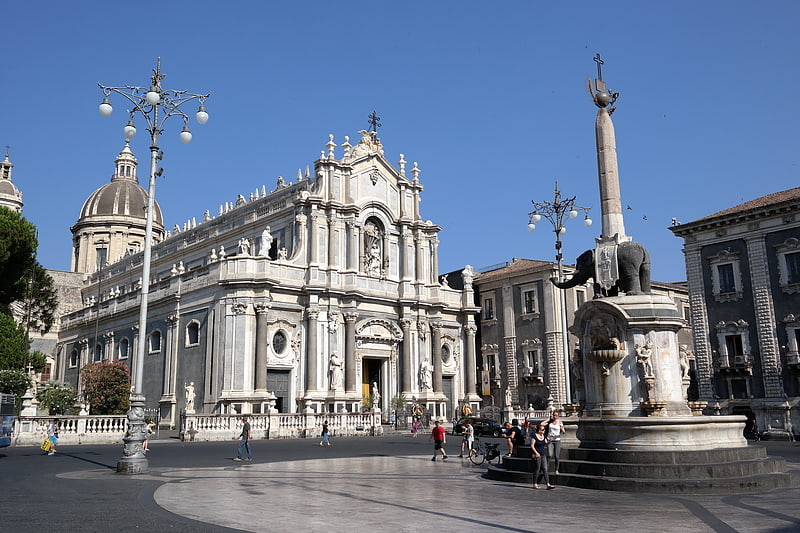
Also known as: Cattedrale di Sant'Agata
Massive cathedral with a baroque facade. Catania Cathedral, dedicated to Saint Agatha, is a Roman Catholic cathedral in Catania, Sicily, southern Italy. It was the seat of the Bishops of Catania until 1859, when the diocese was elevated to an archdiocese, and since then has been the seat of the Archbishops of Catania.[36]
Address: Piazza Duomo, 1, 95124 Catania (Catania)
Palazzo dei Normanni, Palermo
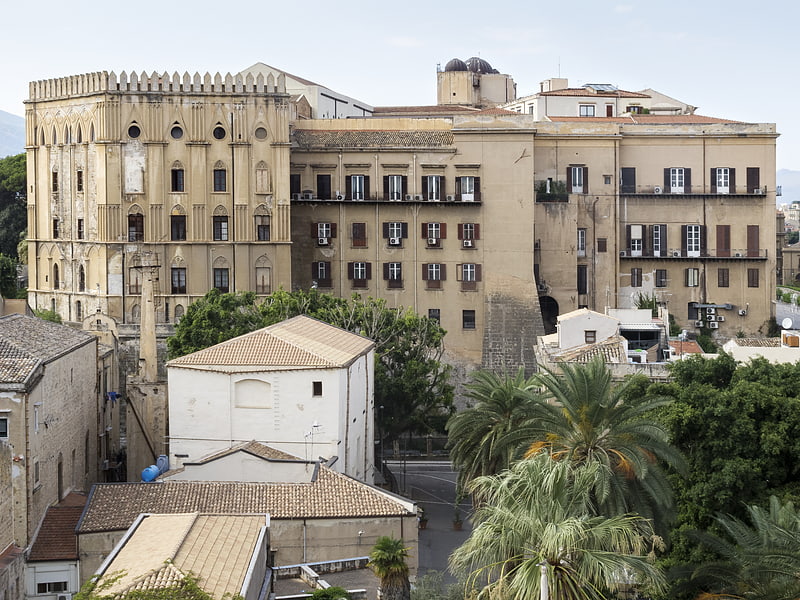
Ornate 9th century palace and museum. The Palazzo dei Normanni or Royal Palace of Palermo is a palace in Palermo, Italy. It was the seat of the Kings of Sicily with the Hauteville dynasty and served afterwards as the main seat of power for the subsequent rulers of Sicily. Since 1946 it has been the seat of the Sicilian Regional Assembly. The building is the oldest royal residence in Europe; and was the private residence of the rulers of the Kingdom of Sicily and the imperial seat of Frederick II and Conrad IV.[37]
Address: 1 Piazza del Parlamento, Palermo (Centro Storico)
MAMbo, Bologna
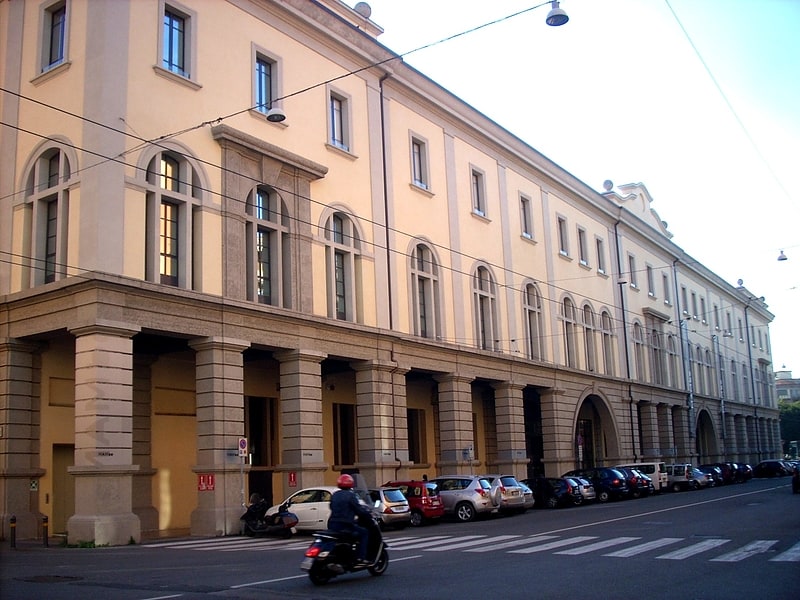
Also known as: Museo d'arte moderna di Bologna
Museum in Bologna, Italy. The Museo d'Arte Moderna di Bologna or MAMbo is a purpose-designed museum of modern and experimental art in Bologna, Italy. The Museo Morandi, which displays a large collection of works by Giorgio Morandi, is temporarily housed in a part of it.[38]
Address: Via Don Giovanni Minzoni, 14, 40121 Bologna (Porto)
Orto botanico di Padova, Padua
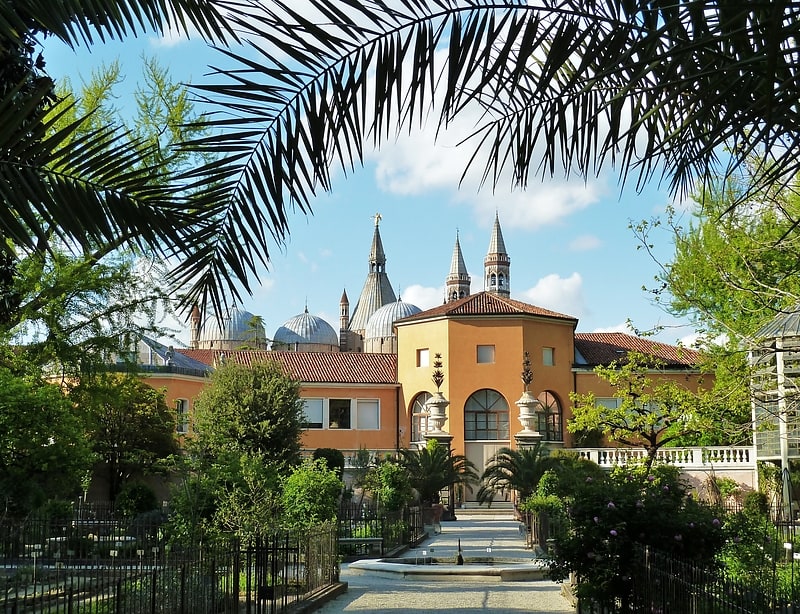
Botanical gardens founded in 1545. The Orto Botanico di Padova is a botanical garden in Padua, in the northeastern part of Italy. Founded in 1545 by the Venetian Republic, it is the world's oldest academic botanical garden that is still in its original location. The garden – affiliated with the University of Padua – currently covers roughly 22,000 square meters, and is known for its special collections and historical design.[39]
Address: Via Orto Botanico, 15, 35123 Padova
Modena Cathedral, Modena
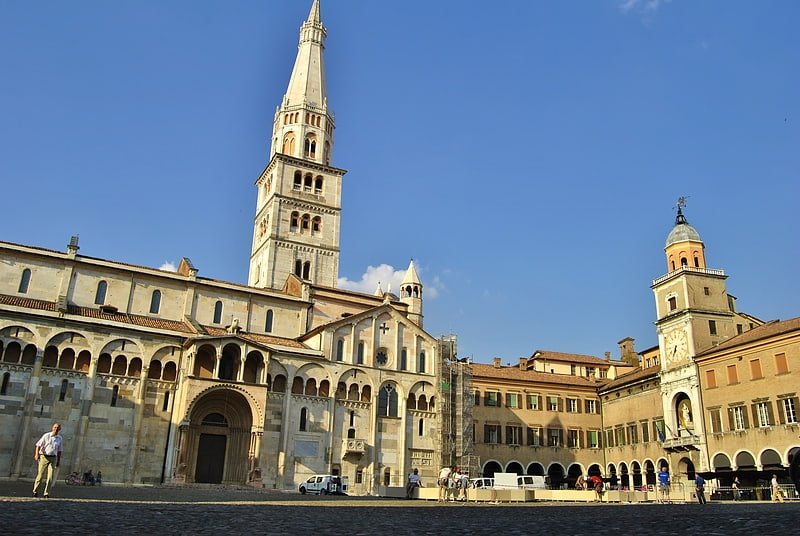
Also known as: Duomo di Modena
Romanesque cathedral with a bell tower. Modena Cathedral is a Roman Catholic cathedral in Modena, Italy, dedicated to the Assumption of the Virgin Mary and Saint Geminianus. Formerly the seat of the Diocese, later Archdiocese, of Modena, it has been since 1986 the archiepiscopal seat of the Archdiocese of Modena-Nonantola. Consecrated in 1184, it is an important Romanesque building in Europe, and along with its bell tower, the Torre della Ghirlandina, is designated as a World Heritage Site.[40]
Address: Corso Duomo, 41121 Modena
Scrovegni Chapel, Padua
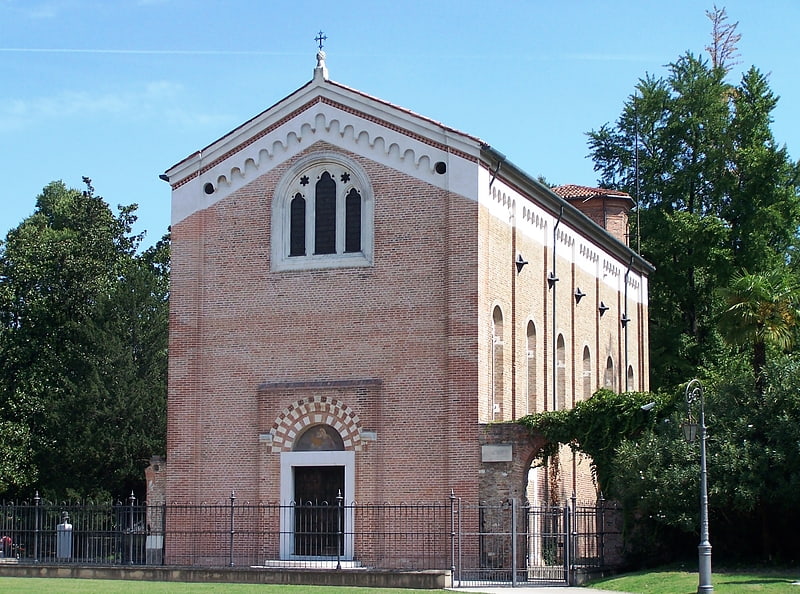
Also known as: Cappella degli Scrovegni
Medieval chapel lined with frescoes. The Scrovegni Chapel, also known as the Arena Chapel, is a small church, adjacent to the Augustinian monastery, the Monastero degli Eremitani in Padua, region of Veneto, Italy. The chapel and monastery are now part of the complex of the Museo Civico of Padua.
The chapel contains a fresco cycle by Giotto, completed about 1305 and considered to be an important masterpiece of Western art. In 2021, the chapel was declared part of the UNESCO World Heritage Site of the 14th-century fresco cycles comprehending 8 historical buildings in Padua city centre. Specifically the Scrovegni Chapel contains the most important frescoes that marked the beginning of a revolution in mural painting and influenced fresco technique, style, and content for a whole century.[41]
Address: Corso Giuseppe Garibaldi, 33, 35137 Padova
Cappella Palatina, Palermo
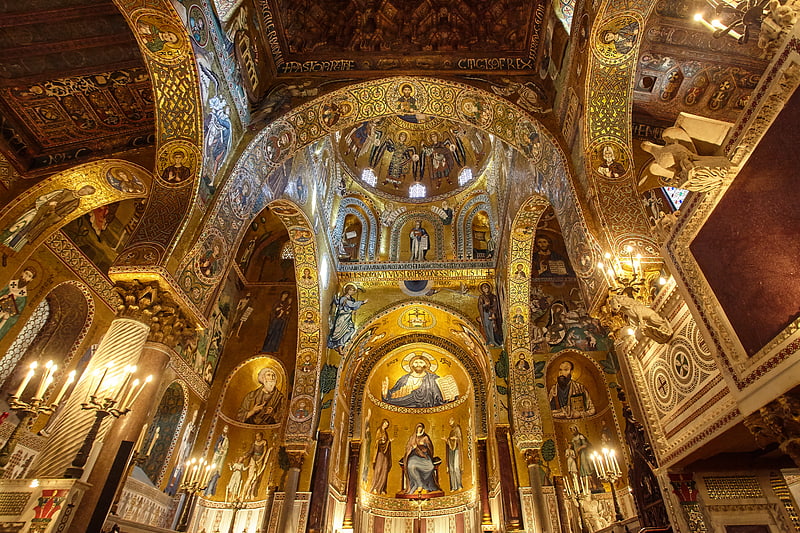
Church famous for its mosaic works. The Palatine Chapel is the royal chapel of the Norman Palace in Palermo, Sicily. This building is a mixture of Byzantine, Norman and Fatimid architectural styles, showing the tricultural state of Sicily during the 12th century after Roger I and Robert Guiscard conquered the island.
Also referred to as a Palace church or Palace chapel, it was commissioned by Roger II of Sicily in 1132 to be built upon an older chapel (now the crypt) constructed around 1080. It took eight years to build, receiving a royal charter the same year, with the mosaics being only partially finished by 1143. The sanctuary, dedicated to Saint Peter, is reminiscent of a domed basilica. It has three apses, as is usual in Byzantine architecture, with six pointed arches (three on each side of the central nave) resting on recycled classical columns. The muqarnas ceiling of the nave and the chapel's rectilinear form show the Fatimid influence in the building's construction[42]
Address: Piazza del Parlamento, 90131 Palermo (Centro Storico)
Palazzo Barbaran da Porto, Vicenza

Art museum in Vicenza, Italy. Palazzo Barbaran da Porto is a palazzo in Vicenza, Italy designed in 1569 and built between 1570 and 1575 by Italian Renaissance architect Andrea Palladio.
Since 1994 the palace is part of the "City of Vicenza and the Palladian Villas of the Veneto" World Heritage Site by UNESCO.
In the palace is located the Museo Palladio and the Centro internazionale di studi di architettura Andrea Palladio (CISA).[43]
Address: Contrà Porti, 11, 36100 Vicenza
Mausoleo di Galla Placidia, Ravenna
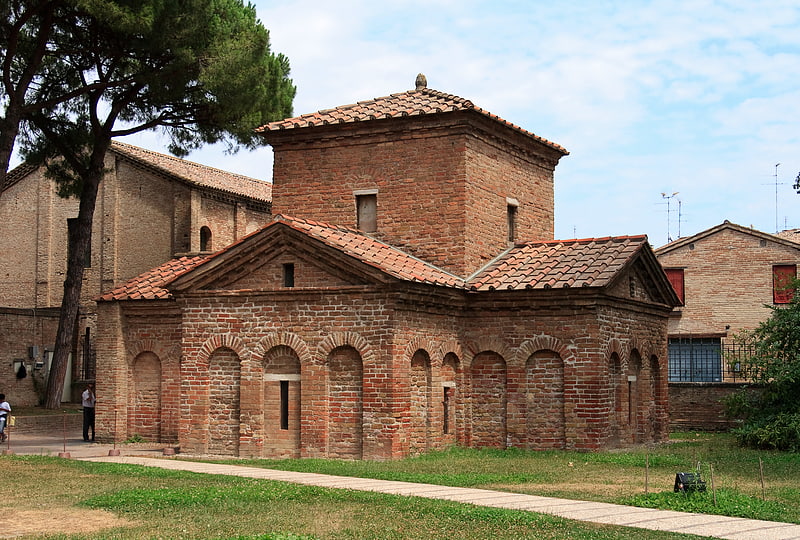
5th-century chapel with colorful mosaics. The Mausoleum of Galla Placidia is a Late Antique Roman building in Ravenna, Italy, built between 425 and 450. It was added to the World Heritage List together with seven other structures in Ravenna in 1996. Despite its common name, the empress Galla Placidia was not buried in the building, a misconception dating from the thirteenth century; she died in Rome and was buried there, probably alongside Honorius in the Mausoleum of Honorius at Old Saint Peter's Basilica.[44]
Address: Via Giuliano Argentario, 22, 48110 Ravenna
Ponte Scaligero, Verona

Also known as: Ponte di Castelvecchio
Reconstructed 1350s bridge with arches. The Castel Vecchio Bridge or Scaliger Bridge is a fortified bridge in Verona, northern Italy, over the Adige River. The segmental arch bridge featured the world's largest span at the time of its construction.[45]
Address: Corso Castelvecchio 2, 37121 Verona (Centro Storico)
Basilica di Sant'Apollinare in Classe, Ravenna
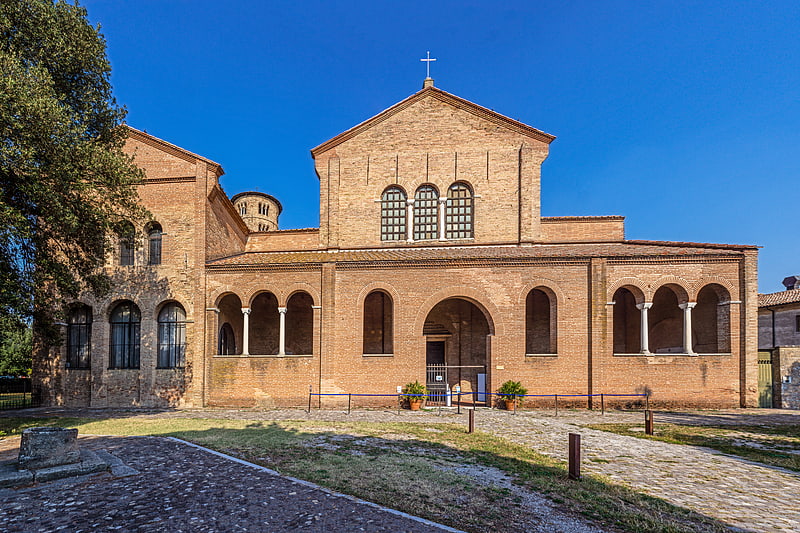
Colorful mosaics in a 6th-century church. The Basilica of Sant' Apollinare in Classe is a church in Classe, Ravenna, Italy, consecrated on 9 May 549 by the bishop Maximian and dedicated to Saint Apollinaris, the first bishop of Ravenna and Classe. An important monument of Byzantine art, in 1996 it was inscribed with seven other nearby monuments in the UNESCO World Heritage List, which described it as "an outstanding example of the early Christian basilica in its purity and simplicity of its design and use of space and in the sumptuous nature of its decoration".[46]
Address: Via Romea Sud, 224, 48124 Classe
Stadio Renato Dall'Ara, Bologna
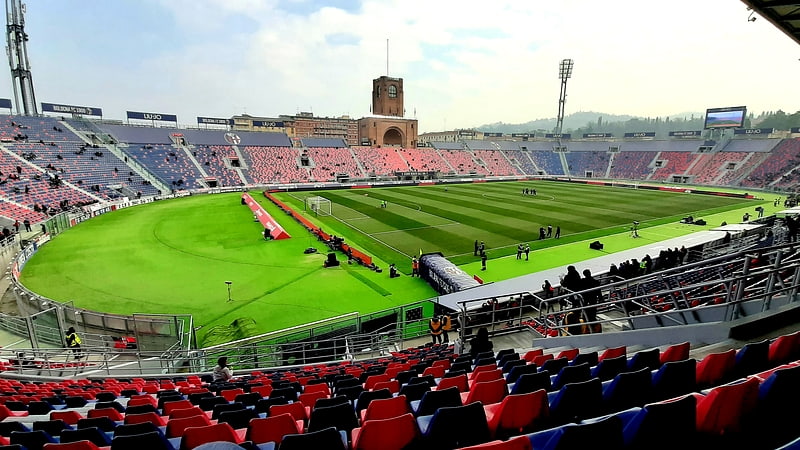
Multi-purpose stadium in Bologna, Italy. Stadio Renato Dall'Ara is a multi-purpose stadium in Bologna, Italy. It is currently used mostly for football matches and the home of Bologna F.C. 1909. The stadium was built in 1927 and holds 38,279. It has also been named Stadio Littoriale. It replaced the Stadio Sterlino. The stadium is named after Renato Dall'Ara, a former president of Bologna for thirty years.
The stadium hosted matches in both the 1934 FIFA World Cup and the 1990 FIFA World Cup. The last match of the tournament played there was the England vs Belgium match in the Round of 16 which ended 1–0 courtesy of an extra-time goal scored by David Platt in the 119th minute.
Located in the Saragozza district, about 3.5 km from the center of the city, it regularly hosts Bologna's home matches. With around 36,000 seats it is the eleventh Italian stadium for capacity, which can increase up to 55,000 for concerts.[47]
Address: Via Andrea Costa, 174, 40134 Bologna (Saragozza)
Museo internazionale e biblioteca della musica, Bologna
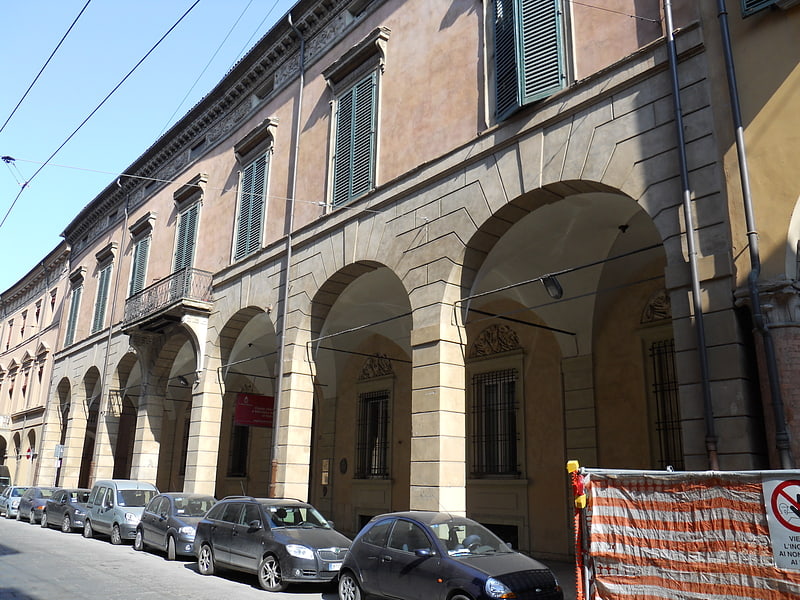
Museum in Bologna, Italy. The Museo internazionale e biblioteca della musica is a music museum and music library in the Palazzo Aldini Sanguinetti, in the historic center of Bologna, Italy.[48]
Address: Str. Maggiore, 34, 40126 Bologna (Santo Stefano)
Amphitheater, Pompeii
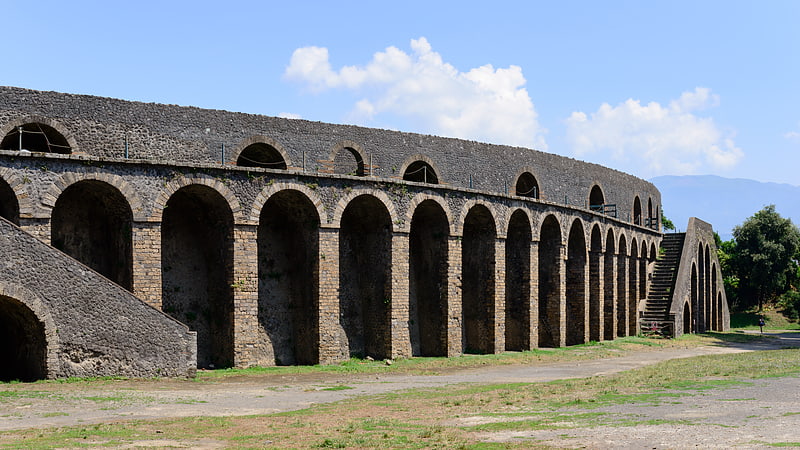
Also known as: Anfiteatro romano di Pompei
Ancient Roman arena for gladiator fights. The Amphitheatre of Pompeii is one of the oldest surviving Roman amphitheatres. It is located in the ancient Roman city of Pompeii, and was buried by the eruption of Vesuvius in 79 AD, that also buried the city of Pompeii and the neighbouring town of Herculaneum.
Six bodies were found during the excavations.[49]
Address: Piazza Anfiteatro, 80045 Pompei
Castello Estense, Ferrara
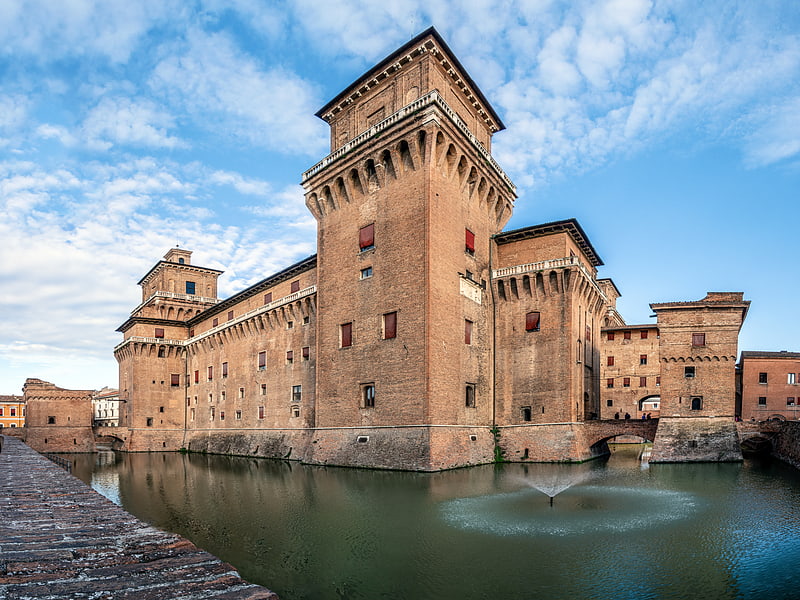
Landmark 14th-century castle and museum. The Castello Estense or castello di San Michele is a moated medieval castle in the center of Ferrara, northern Italy. It consists of a large block with four corner towers.[50]
Address: Largo Castello, 1, 44121 Ferrara